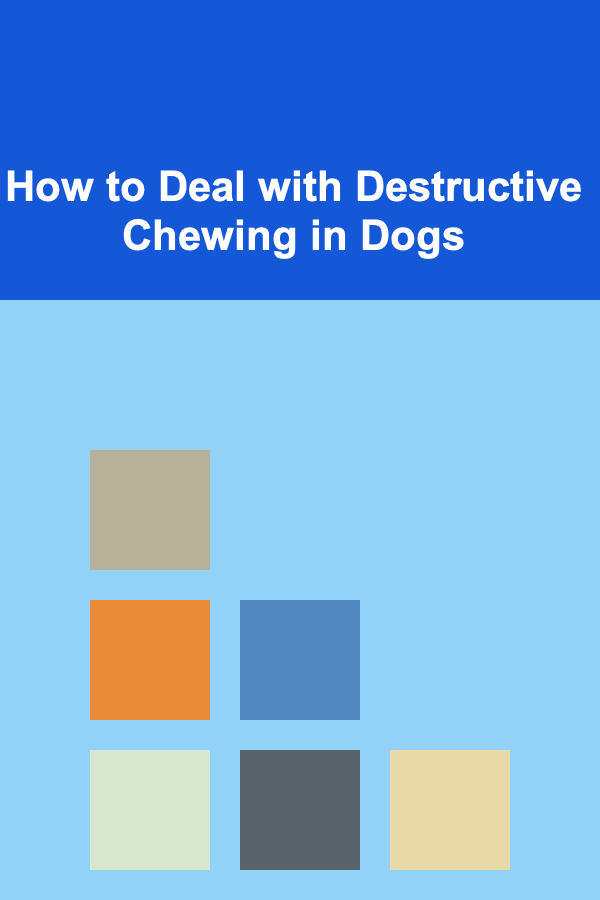
How to Deal with Destructive Chewing in Dogs
ebook include PDF & Audio bundle (Micro Guide)
$12.99$6.99
Limited Time Offer! Order within the next:

Destructive chewing is a common behavioral issue that many dog owners face. While dogs may chew for various reasons, excessive chewing can lead to damage to furniture, shoes, and other household items. Understanding the causes of destructive chewing and learning how to address it effectively is crucial for both the dog's well-being and the peace of mind of the owner. In this article, we'll explore the psychology behind destructive chewing, practical solutions to prevent it, and tips on how to manage it.
The Causes of Destructive Chewing
Before diving into solutions, it's important to understand why dogs chew in the first place. Dogs chew naturally, and when done in moderation, it's a healthy behavior. However, when chewing becomes destructive, it may be indicative of underlying issues that need to be addressed.
1. Teething in Puppies
Puppies are often the main culprits when it comes to destructive chewing. Much like human babies, puppies go through a teething phase where their baby teeth fall out and are replaced by adult teeth. This can be an uncomfortable and painful process, and chewing helps alleviate the discomfort. Puppies may chew on anything they can find to help soothe their gums, which often leads to chewed-up shoes, furniture, and more.
2. Boredom and Lack of Mental Stimulation
Dogs are intelligent creatures that need mental stimulation to stay happy and healthy. If they do not have enough activities or interactions to keep them engaged, they may resort to chewing as a way to entertain themselves. Boredom can be a major cause of destructive chewing, especially in high-energy breeds that require more exercise and mental enrichment.
3. Separation Anxiety
Dogs are social animals and can become anxious when left alone. This separation anxiety can manifest in several ways, including excessive barking, pacing, and chewing. When a dog is left alone for extended periods, they may chew on furniture or other household items as a way to self-soothe and cope with their anxiety.
4. Exploration and Attention-Seeking
Dogs explore the world through their senses, including taste. Chewing can be a way for them to investigate their environment. Puppies and young dogs, in particular, may chew on objects as part of their natural curiosity. In some cases, dogs chew to get attention from their owners, especially if the owner reacts strongly to the behavior, even if that reaction is negative.
5. Hunger or Nutritional Deficiencies
If a dog is not being fed properly or is hungry, they may resort to chewing as a way to satisfy their craving for food. Nutritional deficiencies, such as a lack of fiber or essential vitamins and minerals, can also cause unusual chewing behavior. Chewing may be a dog's attempt to compensate for these deficiencies.
6. Stress or Anxiety
In addition to separation anxiety, dogs may chew as a response to other forms of stress or anxiety. Changes in routine, a move to a new home, or the introduction of a new family member or pet can cause stress. Dogs may chew on objects to cope with feelings of insecurity or stress, especially if they don't have a healthy outlet for their emotions.
How to Manage and Prevent Destructive Chewing
Once the root cause of destructive chewing is identified, the next step is to implement strategies to manage and prevent it. Here are several effective techniques that can help address this behavior:
1. Provide Appropriate Chew Toys
One of the simplest and most effective ways to stop destructive chewing is to provide your dog with appropriate chew toys. Chew toys serve as a positive outlet for their natural chewing instinct and can keep them occupied for hours. Look for toys that are durable and safe for your dog's size and chewing strength. Rubber toys, nylon bones, and stuffed toys are all good options. Avoid toys that can easily break apart or pose a choking hazard.
Tips for Choosing Chew Toys:
- Choose toys that are made from non-toxic materials.
- Select toys that are the right size for your dog; too small, and they may pose a choking risk, too large, and your dog may lose interest.
- Offer a variety of textures to keep your dog entertained.
2. Increase Physical Exercise
A lack of physical activity can contribute to destructive chewing, especially in high-energy breeds. Make sure your dog is getting enough exercise to burn off excess energy. Regular walks, playtime, and interactive games can help satisfy your dog's physical and mental needs. For particularly active breeds, daily jogs, hikes, or agility training might be necessary.
How Much Exercise Does Your Dog Need?
- Puppies require more frequent exercise, but it should be low impact to protect their developing joints.
- Adult dogs typically need 30 minutes to two hours of exercise per day, depending on their breed and energy level.
- Senior dogs may require less, but regular movement is still essential for their health.
3. Address Boredom with Mental Stimulation
If your dog is chewing out of boredom, providing mental stimulation can be a game-changer. Interactive toys, puzzle feeders, and obedience training are excellent ways to keep your dog's mind engaged. You can also try scent work or teaching your dog new tricks. Activities that challenge their problem-solving abilities are ideal for reducing boredom-related chewing.
Examples of Mental Stimulation:
- Puzzle toys that dispense treats when solved.
- Hide-and-seek games where you hide treats or toys around the house for your dog to find.
- Training sessions where you teach your dog new commands or reinforce old ones.
4. Use Deterrent Sprays
Deterrent sprays are a common tool for preventing destructive chewing. These sprays have an unpleasant taste that discourages dogs from chewing on furniture, shoes, and other items. Common deterrent sprays include bitter apple or citrus-based solutions. Be sure to choose a spray that is safe for both your dog and your furniture.
How to Use Deterrent Sprays:
- Apply the spray to furniture, cords, or other items that your dog tends to chew.
- Reapply the spray as needed, especially after cleaning or if the scent begins to fade.
- Use the spray consistently to help break the chewing habit.
5. Crate Training and Controlled Space
For dogs with separation anxiety, crate training can be an effective way to manage destructive chewing when you are not home. A crate provides a safe space for your dog and can help prevent them from chewing on furniture or household items when left unsupervised. Start by making the crate a positive space where your dog can relax and feel secure. Ensure that they have comfortable bedding, water, and some safe chew toys inside.
Crate Training Tips:
- Gradually introduce your dog to the crate by leaving the door open and placing treats or toys inside.
- Never use the crate as a form of punishment.
- Start with short periods of time in the crate and gradually increase the duration as your dog becomes more comfortable.
6. Reduce Separation Anxiety
If your dog's destructive chewing is a result of separation anxiety, addressing the anxiety is key to preventing further damage. Some methods include:
- Gradual desensitization: Start by leaving your dog alone for short periods and gradually increase the time. This helps them get used to being alone without feeling anxious.
- Creating a safe space: Designate a specific area where your dog can stay when you leave, complete with their favorite toys and bedding.
- Consult a veterinarian or professional dog behaviorist: If the anxiety is severe, a vet may recommend anxiety-reducing products like pheromone diffusers or medication to help calm your dog.
7. Reinforce Positive Behavior
Positive reinforcement is a powerful tool in modifying behavior. When your dog chews on appropriate toys or behaves calmly, reward them with praise, treats, or extra playtime. This helps your dog learn the difference between acceptable and unacceptable chewing.
How to Use Positive Reinforcement:
- When your dog chews on their toy instead of your furniture, immediately reward them with praise or a treat.
- Redirect them gently if they start chewing on something inappropriate and offer the correct item to chew on.
- Consistently reinforce positive behavior to establish a strong association between the desired behavior and the reward.
8. Veterinary Consultation
In some cases, destructive chewing may be linked to underlying medical conditions. If you've tried several methods to stop your dog's chewing behavior without success, it may be worth consulting a veterinarian. A vet can rule out any medical issues, such as dental problems, gastrointestinal disorders, or nutritional deficiencies, that may be contributing to the chewing behavior.
Conclusion
Destructive chewing in dogs is a common issue, but it's one that can be managed with patience, understanding, and the right strategies. By providing appropriate chew toys, increasing exercise and mental stimulation, addressing separation anxiety, and using deterrents, you can help your dog break the destructive chewing habit. Understanding the underlying causes and consistently reinforcing positive behavior will lead to a happy, well-behaved dog and a damage-free home.

How to Enjoy the Process of Home Renovation
Read More
How to Involve Family Members in Jewelry Organization
Read More
How to Perform Regular Home Inspections to Spot Issues Early
Read More
How to Set Up a Pet Care Budget for Expenses and Emergencies
Read More
How to Track Your Spending with Financial Apps and Tools
Read More
How to Create Custom Art Prints with Your Own Photos
Read MoreOther Products

How to Enjoy the Process of Home Renovation
Read More
How to Involve Family Members in Jewelry Organization
Read More
How to Perform Regular Home Inspections to Spot Issues Early
Read More
How to Set Up a Pet Care Budget for Expenses and Emergencies
Read More
How to Track Your Spending with Financial Apps and Tools
Read More